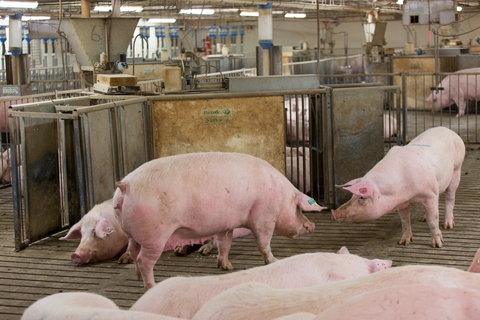Quick facts
Grouping sows by parity can improve performance and well-being of young sows in group-gestation housing systems. Improving young sow performance can help improve lifetime output of these sows. Ultimately, it can help improve production efficiency of sow herds in group-housing systems.
Sow aggression in group-housing systems
Aggression among sows commonly occurs at mixing in group-gestation housing systems. The higher aggression may cause injuries, increased stress and reduced pregnancy rates of sows. Sows use aggression to create a dominant ranking within a group. Thus, this aggression is certain in group housing systems despite the following.
- Available space
- Group size
- Bedding
- Pen design
- Feeding plan
In turn, you should focus on protecting sows that are more prone to aggression. Sorting sows by parity can offer a better way to reducing aggression effects in sows. Parity refers to the number of times a sow has given birth.
Aggression between younger and older sows
Most producers that use group-housing systems house gilts separately to prevent aggression from older sows. But, after first farrowing, producers usually house first parity sows in pens with older sows.
On average, young sows have 25 percent less body weight than mature sows. Since young sows are smaller than mature sows, they usually rank lower in group-housing systems. As a result, compared to mature sows, young sows will
- Lose most fights at mixing
- Suffer more injuries
- Be more stressed (higher cortisol levels)
Early aggression results in lower-ranking sows becoming fearful of further conflict when getting feed or water. This can lead to poor feed intake and reproductive loss. Producers may cull young sows early because of poor conception and lameness caused by aggression. Early culling reduces lifetime output and production efficiency of sow herds.
Sorting sows by parity
In terms of body weight and size, first parity sows are more like gilts than mature sows. Thus, housing first parity sows in gilt-pens rather than in sow-pens can help prevent young sows from aggression. As a result, their performance and welfare may be less at risk in group-housing systems.
Researchers at the University of Minnesota West Central Research and Outreach Center looked at the performance and well-being of young sows grouped by parity in group-housing systems. The Minnesota Pork Board financially supported this two-year project.
Data for this research shows that compared to young sows (first parity sows) housed in sow-pens, young sows housed in gilt-pens:
- Had less skin tears from aggression at mixing.
- Had more fights, but won more fights.
- Had a greater farrowing rate (the number of sows farrowed as a percentage of the number of sows used for breeding).
- Gained greater weight during the gestation period.
Reviewed in 2018


